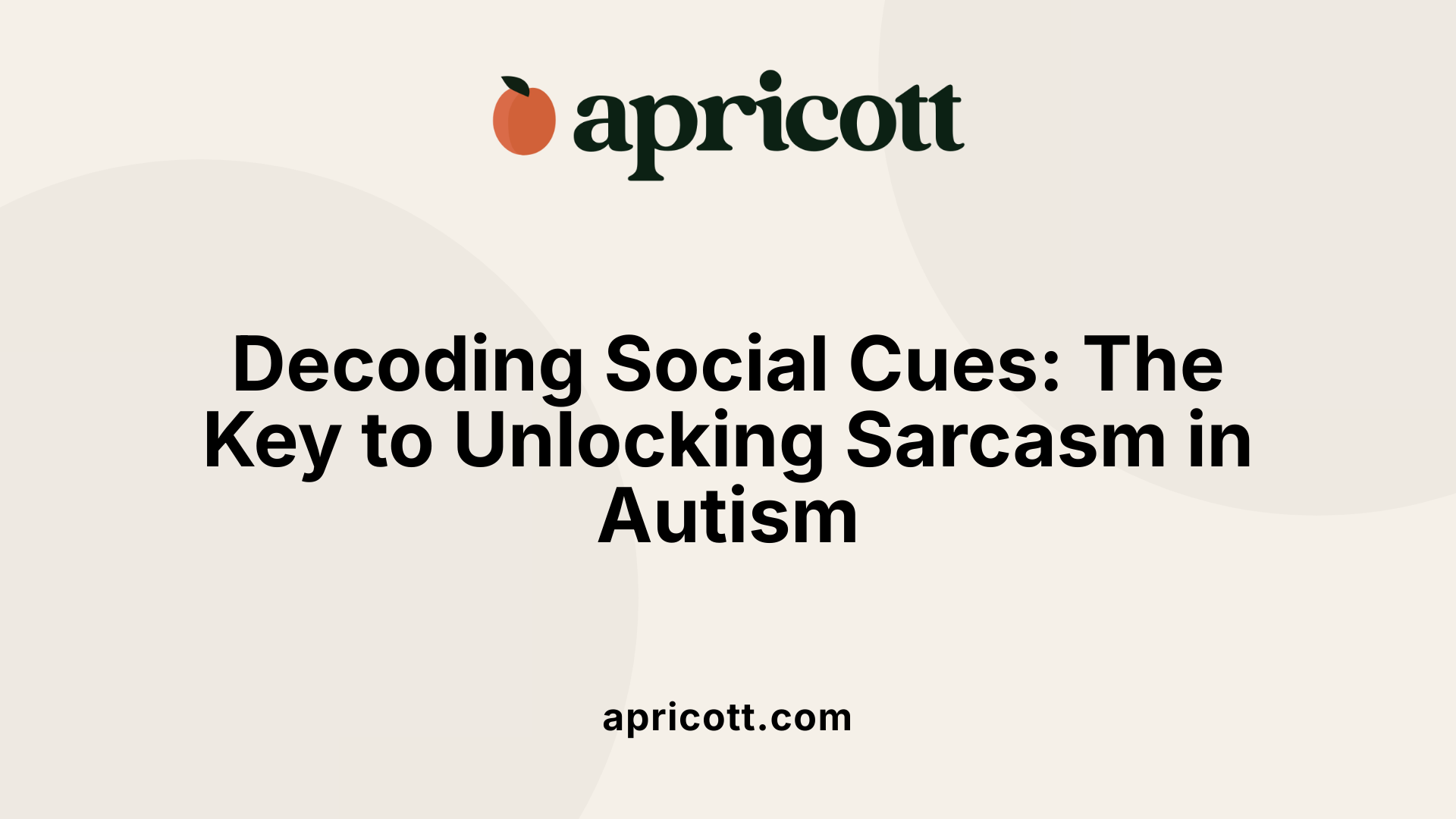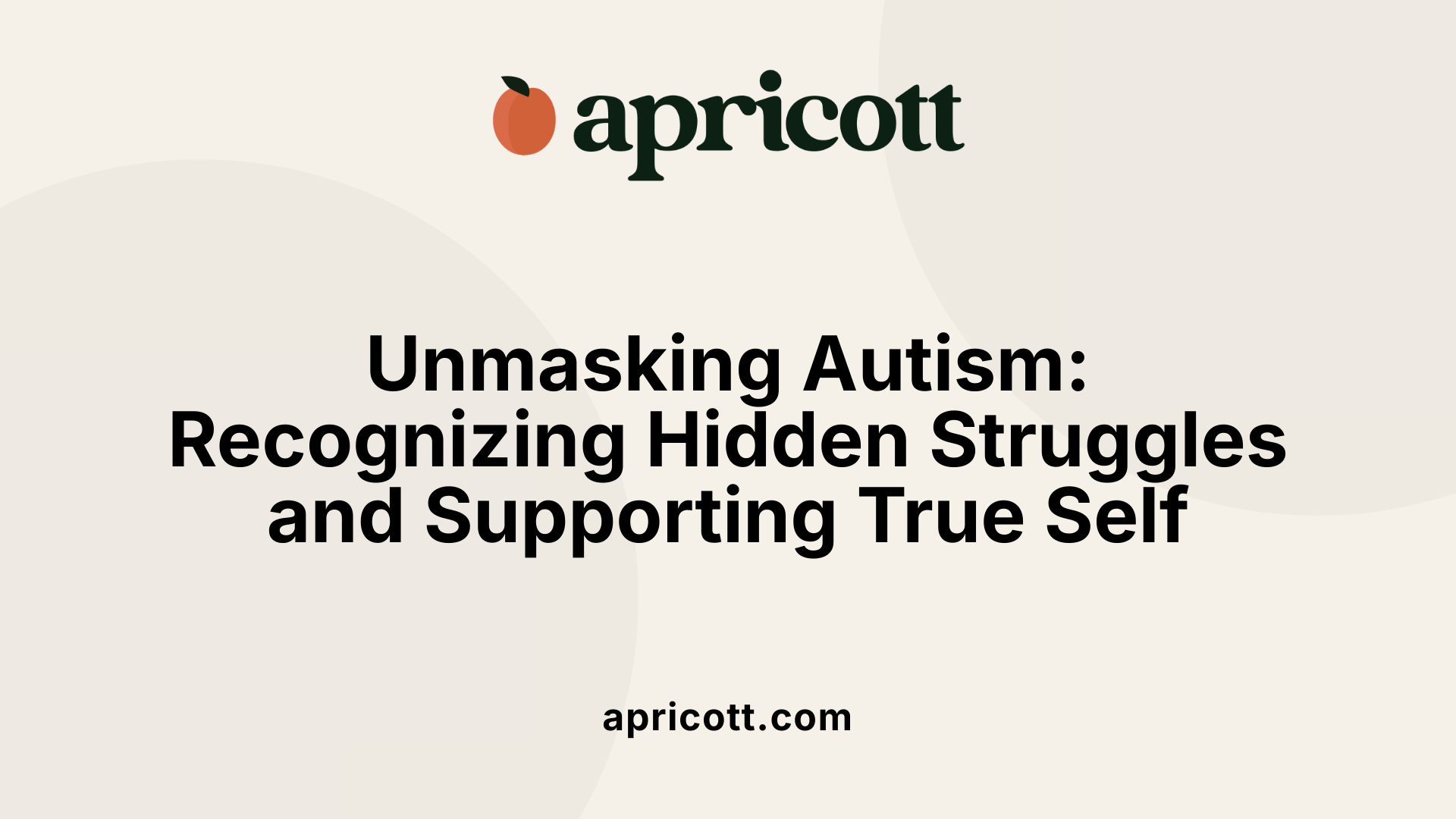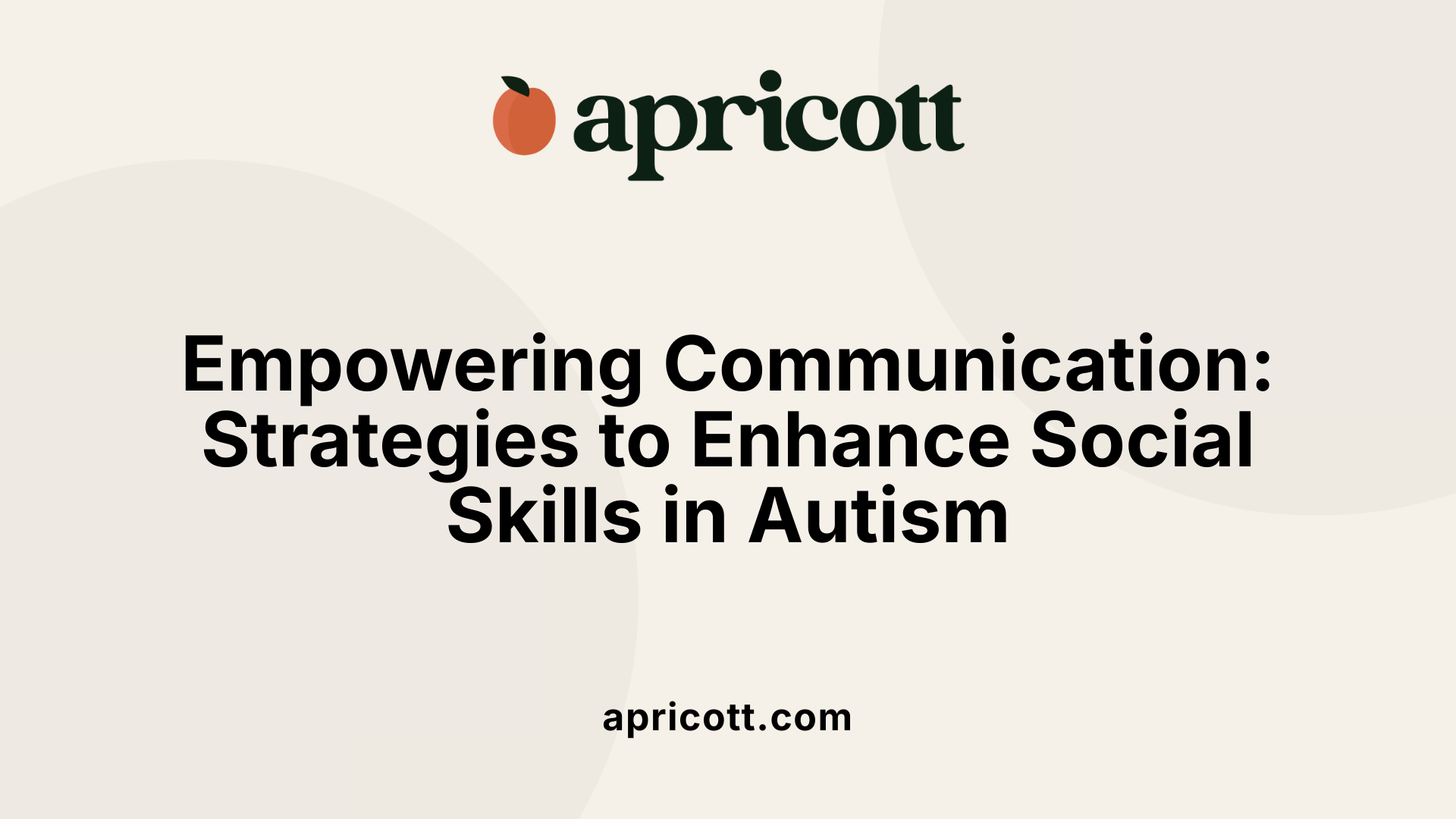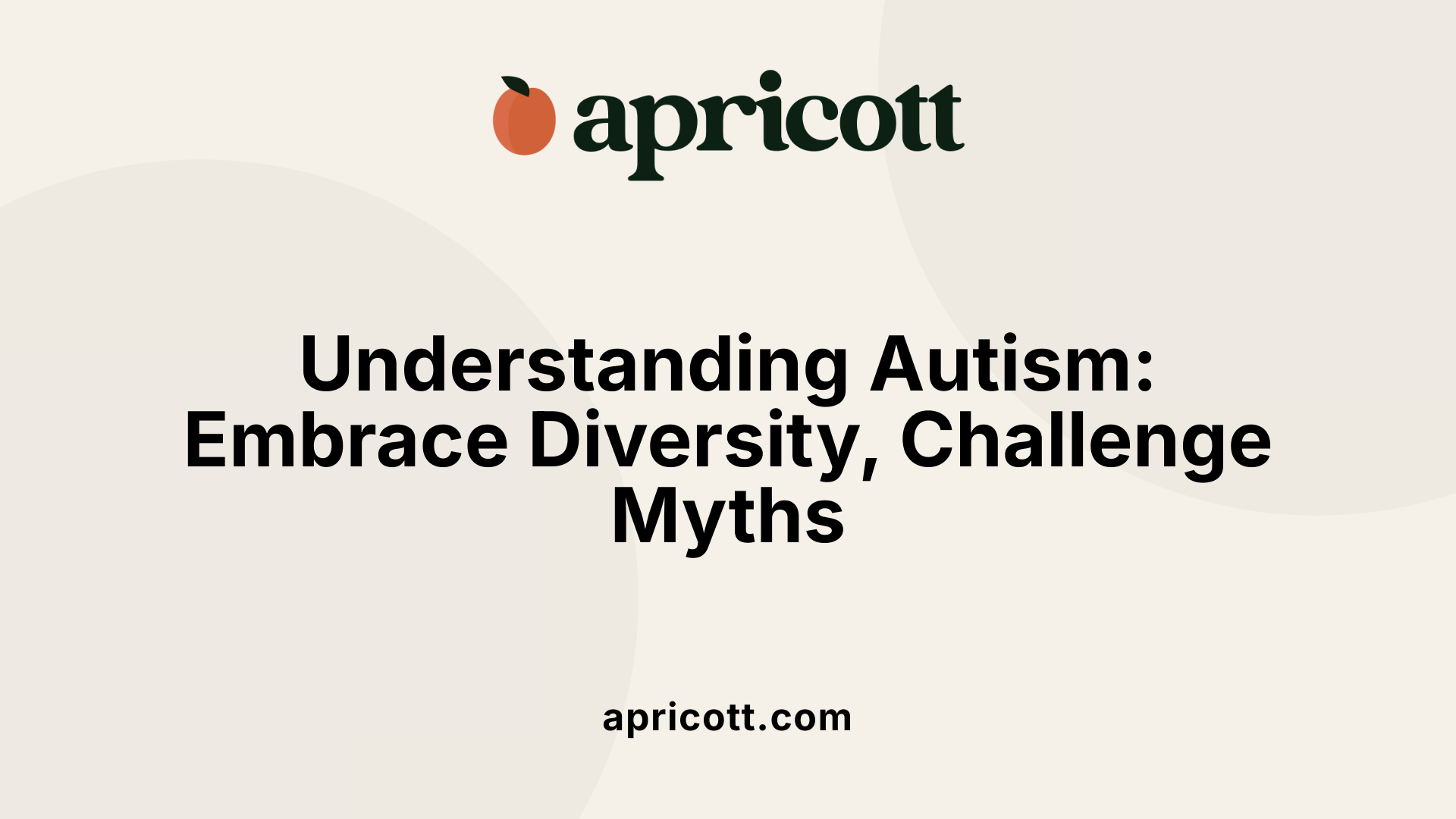Understanding the Social and Cognitive Landscape of Autism
Autism spectrum disorder (ASD) presents diverse challenges, particularly in social communication. Among these, understanding sarcasm is often highlighted as a complex area. This article explores the nature of ASD, focusing on how individuals on the spectrum perceive social cues like sarcasm, the associated cognitive and perceptual differences, and ways to support improved social understanding.
Defining Autism Spectrum Disorder and Its Traits
Why Do Autistic People Struggle to Understand Sarcasm?
Autistic individuals often have difficulty interpreting sarcasm, especially during adolescence. This challenge stems primarily from difficulties in understanding social cues and emotional expressions, which are vital for grasping the nuances of sarcasm. Sarcasm often relies on subtle changes in tone, facial expressions, and contextual clues—areas that many autistic people find complex to interpret.
How Does Autism Affect Social and Communication Skills?
Autism spectrum disorder (ASD) impacts how a person perceives and processes social information. Difficulty recognizing nonverbal cues like body language and facial expressions can hinder understanding sarcasm. Many autistic individuals interpret language very literally, which makes recognizing the implicit humor or intent behind sarcasm especially challenging.
Do All Autistic Individuals Have Trouble with Sarcasm?
Since autism is a spectrum, each person’s ability to understand sarcasm varies. Some autistic individuals may develop skills to recognize and interpret sarcasm over time, especially with support and social training. Others might continue to find it difficult due to their unique social cognition profile.
What Are the Developmental Patterns for Understanding Sarcasm?
Children with autism, including those with Asperger syndrome, often display a specific weakness in understanding nonliteral language like humor, irony, teasing, and sarcasm. While their vocabulary might be sophisticated early on, their comprehension of the intent behind language remains limited. They tend to analyze social interactions carefully and apply rigid rules, which can impair understanding subtle cues.
Why Is Recognizing Sarcasm Difficult for Girls and Women with Autism?
Girls with autism frequently mask their difficulties by mimicking social behaviors and using learned scripts. This masking can make it harder for clinicians to recognize their struggles with social cues, including sarcasm. Endogenous behaviors such as intense interests or socially acceptable hobbies may also obscure underlying communication challenges.
How Do These Difficulties Affect Behavior and Mental Health?
Challenges in understanding sarcasm and social cues may lead to social misunderstandings, frustration, and anxiety. Many autistic individuals, particularly females, experience higher rates of anxiety and depression partly due to these ongoing social difficulties and masking behaviors.
Strategies to Improve Understanding of Sarcasm
Supportive approaches include tailored social skills training, visuals, social stories, and explicit teaching of social cues. Incorporating an individual's interests and strengths into learning activities helps engagement. Clear communication, patience, and positive reinforcement are essential to foster understanding.
| Aspect | Challenges | Support Strategies | Notes |
|---|---|---|---|
| Social Cues and Expressions | Difficult to interpret sarcasm, irony, humor | Use visual aids, social stories, explicit instructions | Autism spectrum varies, individual differences present |
| Language and Communication | Literal interpretation, understanding figurative language | Early intervention, communication therapy | Language ability can be intact but pragmatics affected |
| Emotional Understanding | Struggles with emotional expressions and cues | Social-emotional skills training | High variability among individuals |
| Masking and Camouflage | Can hide social difficulties, delay diagnosis | Awareness and recognition of masking behaviors | Particularly prevalent among girls |
Understanding sarcasm in autistic individuals requires recognizing the diverse ways they experience social cues. While many find it challenging, targeted support and understanding can foster better social communication, promoting greater inclusion and confidence.
The Impact of Social Cognition on Sarcasm Comprehension

Do autistic people understand sarcasm?
Many autistic individuals, especially those with High Functioning Autism or Asperger Syndrome, can recognize sarcastic intent and grasp when someone is being ironic. They may understand sarcasm when it is made explicit or when social stereotypes and cues are clearly outlined. However, they often face challenges in automatically detecting subtle social signals such as tone of voice, facial expressions, and body language during everyday conversations.
Research shows that some adults on the autism spectrum indeed understand and use sarcasm effectively, but many others find it difficult due to struggles in perceiving social norms and non-verbal communication cues. Explicit teaching—such as social skills training—can significantly help improve their understanding. The variability across individuals means that some may understand sarcasm better than others, depending on their experiences, comprehension skills, and the context in which communication occurs.
Overall, the ability to comprehend sarcasm among autistic people depends on individual abilities, familiarity with the social environment, and whether the sarcastic intent is made more apparent through contextual clues or explicit explanations.
Perceptual and Cognitive Differences in Autism Affecting Social Cues
How do cognitive and perceptual differences in autism impact understanding of social cues?
Autistic individuals often encounter unique challenges when it comes to interpreting social cues, primarily due to differences in perception and cognition. One of the hallmark features is sensory sensitivity, which can make everyday stimuli overwhelming. For instance, heightened sensitivity to sounds, lights, textures, and smells may lead to sensory overload. This overload diverts focus and makes it difficult to observe and interpret social signals like facial expressions, body language, or tone of voice.
Beyond sensory sensitivities, cognitive processing plays a significant role. Many autistic individuals tend to analyze social interactions through rigid behavioral frameworks. They may apply strict rules or patterns to understanding social situations, which can hinder their ability to interpret more subtle or complex cues such as sarcasm, irony, or teasing. These cues often rely on understanding context, tone, and facial expressions—elements that can be challenging for those with autism to process quickly or accurately.
A notable aspect is the literal interpretation of language. Children and adults with autism might understand words at face value without recognizing sarcasm or humor. For example, when a speaker says,
Developmental Trajectory of Sarcasm Comprehension in Autism
How does understanding sarcasm develop with age in autistic individuals?
Autistic people often face challenges in recognizing sarcasm, primarily because of difficulties in interpreting social cues and emotional expressions. This impairment tends to be more evident during adolescence when peer interactions and social nuances become more complex.
The spectrum nature of autism means that each individual has a unique developmental path. Some autistic individuals gradually improve their understanding of sarcasm over time, especially when they receive targeted support and social skills training. This development results from increased exposure to social interactions, explicit teaching, and practice.
However, for others, the tendency towards literal language comprehension persists. They might continue to interpret sarcastic comments in a straightforward, literal manner, which can sometimes lead to misunderstandings or social difficulties.
Can autistic people learn and adapt their understanding of sarcasm?
Yes, many can learn to interpret sarcasm better, especially with early intervention. Support strategies such as social stories, visual aids, and structured social activities can significantly help.
Early intervention plays a crucial role. When introduced during childhood, programs that focus on social understanding can improve an autistic child's skills in recognizing nonverbal cues, irony, and humor.
As they grow, ongoing support can foster more flexibility in social thinking. This aids in understanding complex social cues, sarcasm included, leading to more meaningful relationships and functional social skills.
The ability to adapt varies widely. Some autistic individuals develop a sophisticated understanding of sarcasm, while others find it persistently challenging, highlighting the importance of personalized approaches.
How early childhood intervention influences social understanding
Early childhood intervention is vital for laying the groundwork for social comprehension. Programs utilizing social stories, visual supports, and social skills training help children grasp concepts like sarcasm, irony, and teasing.
By addressing communication delays and sensory sensitivities early on, these interventions reduce frustration and behavioral issues, creating a more conducive environment for learning.
Through consistent support, children can become more adept at navigating social interactions, recognizing less obvious cues, and interpreting figurative language.
Ongoing support as they mature helps further refine these skills, fostering independence and social confidence.
| Age Range | Social Skill Development Focus | Typical Support Strategies | Expected Outcomes |
|---|---|---|---|
| Early childhood | Basic social cues, communication skills | Visual supports, social stories, structured social activities | Improved understanding of social cues, reduced frustration |
| Middle childhood | Recognizing irony, humor, teasing | Role-playing, peer interactions, explicit teaching | Better interpretative skills, increased social participation |
| Adolescence and beyond | Complex social interactions, sarcasm, figurative language | Continued social skills training, real-world practice | Enhanced social cognition, more nuanced social understanding |
Understanding how sarcasm develops over time in autistic individuals reveals the importance of early tailored support. Recognizing individual differences helps professionals and families foster social skills effectively, easing social navigation and improving quality of life.
The Role of Masking and Its Effects on Diagnosis and Social Perception

How does masking affect autism diagnosis and social understanding, especially in females?
Masking behaviors are common among females with autism spectrum disorder (ASD). These behaviors involve mimicking social cues, using learned scripts, or displaying facial expressions to cover difficulties with social interactions. Girls and women often learn to imitate typical social behaviors from a young age to blend in, which can hide their true challenges.
This strategy makes it harder for clinicians to recognize autism in females, frequently leading to late or missed diagnoses. Masking masks the core symptoms, so assessments based solely on observable behaviors might not reveal underlying issues.
Additionally, masking impacts social understanding. Females who mask their struggles may appear socially competent but often experience internal confusion or stress. They might not truly understand the nuances of social cues and humor, especially sarcasm, which requires interpreting nonliteral language.
Over time, sustaining these masks demands significant mental effort, contributing to high rates of anxiety, depression, and burnout among autistic females. Recognizing the presence of masking behaviors is crucial for accurate diagnosis, better social support, and mental health intervention.
What are the implications of masking for supporting autistic females?
Supporting females who mask their autism requires understanding and validating their experiences. Creating safe environments where they can express feelings without fear of judgment is essential.
Assessment approaches should go beyond surface behaviors. Professionals can employ alternative strategies, such as exploring internal emotional states, to better understand the individual's true experiences.
Educational settings and social programs should promote acceptance of diverse social styles. Explicit social skills training tailored to individual needs can help, especially when it respects differences rather than forcing conformity.
Awareness of mental health challenges linked with masking, like exhaustion or burnout, guides more effective support. Providing mental health resources and addressing these issues early can prevent more severe psychological effects.
In summary, understanding masking as a significant obstacle in diagnosis and social perception fosters more empathetic support, early detection, and interventions that truly reflect the needs of females on the spectrum.
Understanding Masking Behaviors in Females with Autism
| Aspect | Description | Impact |
|---|---|---|
| Imitation of social cues | Using learned expressions to appear socially appropriate | Hides true difficulties, leads to underdiagnosis |
| Use of scripts | Reciting common phrases to navigate interactions | Masks spontaneous social struggles |
| Facial expressions | Mimicking emotions to fit in | Can create confusion about genuine feelings |
| Impact on diagnosis | Symptoms are less observable | Diagnosis often delayed or missed |
| Mental health | Internal stress from masking | Elevated risk for anxiety and depression |
| Social perception | May appear socially skilled | Misunderstands the internal experience |
Broader Topics Touching on Autism and Masking
| Topic | Details | Related Concerns |
|---|---|---|
| Masking behaviors in autism | Adaptive strategies to cover difficulties | Diagnostic challenges, social interaction issues |
| Gender differences in autism | Females more likely to mask | Underdiagnosis, misinterpretation of symptoms |
| Impact on mental health | Masking increases exhaustion and stress | Anxiety, depression, burnout |
| Diagnosis considerations | Need for nuanced assessment | Emphasis on internal experiences |
| Social perception | Masking affects how others view autistic individuals | Potential misjudgment, social exclusion |
Understanding the nuances of masking behaviors, especially in females, is vital. It highlights the importance of comprehensive evaluation and tailored support to ensure that all autistic individuals receive accurate diagnosis and appropriate care.
Supporting Autistic Individuals with Social Skills and Communication

How can support strategies improve social understanding and communication?
Supporting autistic individuals in developing their social skills primarily involves targeted strategies that cater to their specific needs. Visual aids and social stories are particularly effective in clarifying social cues and expectations, which can be difficult for autistic people due to challenges in interpreting social cues and emotional expressions. These tools provide concrete examples of appropriate behavior, helping individuals understand the nuances of social interactions.
Clear instructions are crucial as well, especially for those who may experience difficulties with figurative language like sarcasm, irony, or teasing. By presenting information in straightforward, literal terms, autistic individuals can better grasp what is expected of them, reducing confusion and frustration.
Structured interventions, like routines and predictable schedules, play a vital role in reducing anxiety and behavioral disruptions. Since many autistic people experience heightened anxiety, establishing daily routines creates a sense of stability and control. This predictability helps them prepare for transitions and social interactions, making these situations less overwhelming.
Incorporating their interests and strengths into activities boosts engagement and motivation. For example, using topics they enjoy can make social skills practice more appealing and relatable.
Behavioral strategies such as positive reinforcement encourage the development of social and communication skills. Rewards and praise for successful interactions foster confidence and motivate continued effort.
Finally, techniques like deep breathing, physical exercise, and scheduled breaks serve as calming tools. They help manage sensory overload and emotional stress, allowing individuals to participate more effectively in social scenarios.
Overall, these combined approaches create a supportive environment where autistic people can improve their social understanding, communicate more confidently, and forge meaningful relationships.
Visual aids, structured interventions, and positive reinforcement
| Strategy | Description | Benefit |
|---|---|---|
| Visual aids | Pictures, charts, social stories | Clarify social cues, expectations, and humor |
| Structured routines | Consistent daily schedules | Reduce anxiety, support transition management |
| Clear instructions | Literal, straightforward language | Minimize misunderstandings about social rules |
| Interests and strengths | Activities tailored to preferences | Increase engagement and motivation |
| Positive reinforcement | Rewards or praise for successful attempts | Build confidence, encourage social prosocial behaviors |
| Calming techniques | Deep breathing, exercise, breaks | Control sensory overload and emotional stress |
How support strategies foster social and communication skills
| Approach | Focus Area | Impact on Social Understanding |
|---|---|---|
| Visual aids & stories | Clarification of social cues | Better understanding of humor, sarcasm, teasing |
| Routine & predictability | Manage anxiety and emotional stress | Greater confidence in social engagement |
| Engagement based on interests | Motivation and enjoyment | Increased participation and learning |
| Reinforcement & positive feedback | Encouragement of effective behaviors | Develops social skills and self-esteem |
| Calming & regulation tools | Emotional regulation | Facilitates more consistent social interactions |
Through consistent application of these strategies, autistic individuals can enhance their social communication. This not only promotes better understanding and relationships but also fosters independence and overall well-being in social environments.
Promoting Awareness and Reducing Misconceptions

What misconceptions about autism and social understanding need to be addressed?
Many myths and misunderstandings surround autism, especially related to social skills and communication. A common misconception is that all autistic people are entirely unable to understand social cues such as sarcasm, irony, or teasing. In reality, autism exists on a spectrum, meaning individuals display a wide range of abilities. Some autistic individuals, particularly during childhood or adolescence, may struggle with grasping sarcasm, especially due to difficulties with social cognition and interpreting emotional expressions. However, others may develop an understanding of these social nuances over time, especially with targeted support.
Another false belief is that autistic individuals are incapable of forming meaningful relationships or engaging in social interactions. While they might face challenges, many desire friendship and connection, often analyzing social situations rigorously or mimicking learned behaviors to fit in. For girls and women with autism, difficulties with social cues can be masked through behaviors like mimicking and scripted conversations, which can lead to underdiagnosis or late diagnosis.
There are also harmful myths linking vaccines to autism or blaming parenting styles, which are unsupported by scientific evidence. These misconceptions have contributed to stigma and misinformation, hindering acceptance and appropriate support.
To address these misunderstandings, public awareness campaigns and autism education are vital. These initiatives aim to provide accurate, nuanced information that highlights the diversity within autism. For instance, understanding that some children with Asperger syndrome comprehend the cognitive aspects of humor but not the intent behind it helps clarify why understanding sarcasm can be difficult.
Moreover, emphasizing individual strengths and differences fosters a more inclusive perspective. Promoting stories and resources that showcase varied abilities encourages the public to view autism not as a deficit but as a different way of experiencing and engaging with the world.
How do awareness campaigns and education initiatives contribute?
Awareness campaigns reach broad audiences, dispelling myths and promoting acceptance. They often feature personal stories, expert insights, and evidence-based information to educate the public about the realities of autism.
Educational programs within schools, workplaces, and community settings offer tailored information about social cues, communication styles, and behavioral differences. These programs stress that understanding, patience, and support can significantly improve social interactions and quality of life for autistic individuals.
Advocacy efforts also work towards policy changes that support inclusion, access to services, and resources for families and individuals affected by autism. By increasing visibility and understanding, these initiatives help reduce stigma and foster environments where autistic individuals can thrive.
Summarizing the importance of accurate information
Recognizing the diversity within the autism spectrum is crucial to combating stereotypes. As some children with autism can eventually understand sarcasm and figurative language, it's important not to generalize abilities based solely on diagnosis.
Furthermore, highlighting that each person with autism is unique supports personalized approaches to education, social integration, and therapy. Moving away from misconceptions enhances social acceptance and encourages societal support for inclusion.
By continuing to promote awareness and autism education, communities can challenge harmful stereotypes and foster environments where autistic individuals are understood, respected, and empowered.
| Aspect | Details | Additional Insights |
|---|---|---|
| Misconceptions | All autistic people can't understand social cues; vaccine or parenting myths | Myths debunked by research, spectrum variability |
| Social understanding | Varies widely; some develop skills over time | Masking behaviors used by girls to blend in |
| Role of campaigns | Broad awareness, myth dispelling | Personal stories, expert info, policy advocacy |
| Education initiatives | Tailored programs, inclusive environments | Focus on patience, support, and individualized approaches |
| Impact on society | Reduces stigma, promotes inclusion | Essential for community integration and acceptance |
| Principles to remember | Autism diversity, not deficits; individual strengths | Supports social, emotional, and educational growth |
The Importance of Empathy and Patience in Supporting Autism

How can increased awareness of social cues enhance support for autistic individuals?
Understanding social cues such as sarcasm, tone of voice, and body language significantly improves how we support autistic people. Autism affects how an individual interprets social signals, making it challenging to recognize nuanced communication like sarcasm or irony.
When caregivers, teachers, and peers become more aware of these differences, they can adjust their interactions more thoughtfully. This awareness promotes clearer, more effective communication strategies that respect each person’s unique way of understanding social interactions.
Enhanced social cue recognition encourages patience and fosters an environment of respect. It helps build trust and comfort, making autistic individuals feel more included and understood. This understanding reduces frustration and prevents misinterpretations that can lead to social withdrawal or behavioral challenges.
Supporting autistic individuals effectively involves shifting focus from merely teaching them to navigate social cues to embracing the concept of mutual understanding, known as the double empathy problem. This perspective recognizes that both autistic and non-autistic people may struggle to understand each other's social world, emphasizing reciprocal understanding rather than one-sided adaptation.
By practicing respectful and empathetic communication, support systems become more responsive and adaptable. This approach advocates for shared efforts to decode social interactions, creating more meaningful connections.
Incorporating these principles can lead to numerous benefits:
- Better social integration and participation
- Fewer misunderstandings and conflicts
- Stronger, more trusting relationships
- Increased confidence and independence for autistic individuals
Ultimately, fostering an environment rooted in empathy and patience enables everyone to learn from each other and grow in understanding, making social spaces more inclusive and supportive for autistic people.
Fostering Inclusive Social Environments
Understanding the nuanced reality of how autistic individuals perceive and interpret social cues, including sarcasm, is vital for creating more inclusive, supportive environments. Recognizing individual differences, employing tailored support strategies, and promoting awareness can bridge gaps in social understanding, empowering autistic people to engage more confidently and authentically in social interactions. While challenges persist, increased knowledge, patience, and empathy can significantly improve their quality of life, fostering genuine connections and social participation.
References
- Autism Spectrum Disorder (ASD) Symptoms & Causes
- Tips for Dealing With an Autistic Child Disrupting Class
- Autism Speaks: Autism support, resources & advocacy
- Female autism checklist
- Asperger syndrome
- Signs and Symptoms of Autism Spectrum Disorder
- Autism symptoms
- Autism spectrum disorder - Symptoms and causes
.svg)
.svg)








